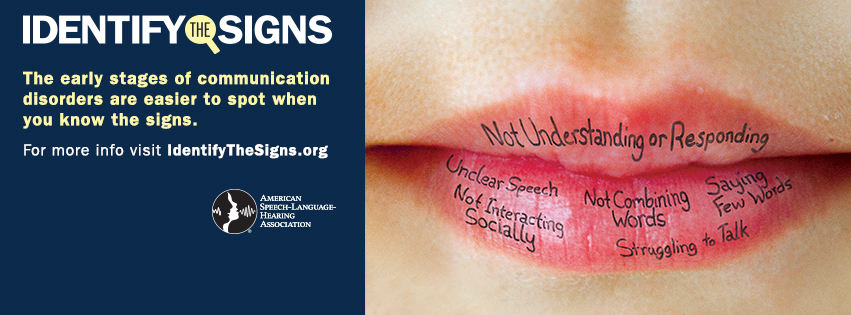A new nationwide effort to educate the public about communication disorders was recently launched by the American Speech-Language-Hearing Association (ASHA). This campaign, called Identify the Signs, aims to help people recognize the early warning signs of communication disorders in children and adults.
An estimated 40 million Americans have trouble speaking or hearing due to a communication disorder. Here in Hingham, Massachusetts, there are parents reading this whose children are struggling to speak or understand language, spouses living with partners whose hearing is deteriorating; and co-workers, neighbors and others who see someone who needs help but don't know what to do. Identify the Signs offers tools to change that.
With eight years of experience working in the field of communication disorders, I have seen the debilitating effects that these issues can have when left unaddressed. Early detection of speech, language, and hearing issues is absolutely critical to improving academic, social, and career outcomes--and improving one's quality of life at any age.
For people with communication disorders, those closest to them are often their biggest asset. Unfortunately, many parents and caregivers are unable to identify the warning signs or dismiss them too readily. A recent poll of speech-language pathologists and audiologists by ASHA reported significant parental delays in getting help for children with communication difficulties. All too often, parents/pediatricians/caregivers rely on the hope that these children will "grow out of it."
Through a series of TV, radio, print, digital public service announcements, and the campaign website, the public can learn about the warning signs and be connected to professional help. I encourage you to visit the website, and share the information and resources you find there. Above all, though, I hope you will seek help if you suspect that you or a loved one shows signs of having a communication disorder. Early diagnosis is the most powerful way to reduce or even reverse their impact and can give your loved ones the opportunity to lead the fullest lives possible.
If you have concerns about your child's communication, please contact Hingham Speech & Language Therapy to see if we can help. In the spirit of the Identify the Signs campaign, Hingham Speech & Language Therapy is offering complimentary articulation screens by appointment. Call 617-840-5445 to schedule your child's screening today!
An estimated 40 million Americans have trouble speaking or hearing due to a communication disorder. Here in Hingham, Massachusetts, there are parents reading this whose children are struggling to speak or understand language, spouses living with partners whose hearing is deteriorating; and co-workers, neighbors and others who see someone who needs help but don't know what to do. Identify the Signs offers tools to change that.
With eight years of experience working in the field of communication disorders, I have seen the debilitating effects that these issues can have when left unaddressed. Early detection of speech, language, and hearing issues is absolutely critical to improving academic, social, and career outcomes--and improving one's quality of life at any age.
For people with communication disorders, those closest to them are often their biggest asset. Unfortunately, many parents and caregivers are unable to identify the warning signs or dismiss them too readily. A recent poll of speech-language pathologists and audiologists by ASHA reported significant parental delays in getting help for children with communication difficulties. All too often, parents/pediatricians/caregivers rely on the hope that these children will "grow out of it."
Through a series of TV, radio, print, digital public service announcements, and the campaign website, the public can learn about the warning signs and be connected to professional help. I encourage you to visit the website, and share the information and resources you find there. Above all, though, I hope you will seek help if you suspect that you or a loved one shows signs of having a communication disorder. Early diagnosis is the most powerful way to reduce or even reverse their impact and can give your loved ones the opportunity to lead the fullest lives possible.
If you have concerns about your child's communication, please contact Hingham Speech & Language Therapy to see if we can help. In the spirit of the Identify the Signs campaign, Hingham Speech & Language Therapy is offering complimentary articulation screens by appointment. Call 617-840-5445 to schedule your child's screening today!

 RSS Feed
RSS Feed